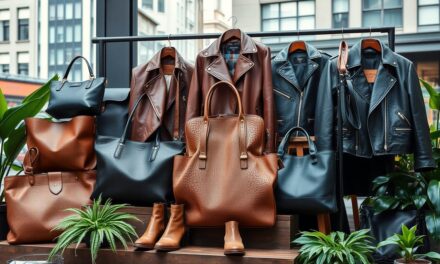Did you know the average American throws away about 81 pounds of clothes yearly? This staggering amount contributes to 6.3% of all waste, yet nearly 95% of used textiles can be reused or recycled. Upcycling old clothes is a creative and impactful way to reduce waste while crafting unique, personalized fashion pieces. Learning to repair and upcycle old clothes can transform outdated garments into trendy, stylish items.
This approach supports sustainable fashion trends and allows you to express your individuality in an eco-friendly way. Embracing upcycling is a practical step toward reducing your environmental footprint while refreshing your wardrobe.
Key Takeaways
- Upcycling helps reduce the 81 pounds of clothing waste per person annually.
- Approximately 95% of textiles can be reused or recycled, presenting sustainable options.
- Transforming old clothes into new fashion pieces minimizes the demand for new materials.
- DIY fashion projects can lead to substantial cost savings and creative freedom.
- Repurposed textiles contribute to sustainability goals by lessening your carbon footprint.
Understanding Upcycling and Its Benefits
Exploring upcycling shows us how to reuse items, like clothes, in creative ways. It turns old or broken clothes into something new and valuable. This is different from recycling because it keeps the clothes looking and feeling good as new.
Learning about upcycling lets us get creative and helps the planet. It’s a way to make old clothes useful again.
What is Upcycling?
Upcycling means making old clothes into something new and useful. It’s a big help in reducing waste. The EPA says we throw away about 70 pounds of clothes every year.
By upcycling, we make clothes last longer and help the environment. It gives old clothes a second chance, showing upcycling’s great benefits.
The Environmental Impact of Upcycling
Upcycling is good for the planet. The fashion world creates over 92 million tons of waste each year. This harms our Earth.
Upcycling saves water and cuts down on carbon emissions. It’s a way to use less of the resources needed to make new clothes. Plus, it helps reduce the amount of waste in landfills.
Statistic and impact chart:
| Statistic | Impact |
| Average person throws away 70 pounds of clothing per year | Contributes to textile waste. |
| 700 gallons of water needed to produce one pair of jeans | Highlights the water scarcity issue. |
| Upcycling can reduce textile waste by 15-20% | Supports sustainability. |
| 92 million tons of fashion industry waste annually | Signifies a major environmental concern. |
| Individuals can save $139 annually through upcycling | Economic benefit from reduced new clothing purchases. |
Why You Should Upcycle Old Clothes
Upcycling old clothes is more than a trend. It’s a practical way to tackle big environmental issues. By giving old clothes a new life, you join a movement to cut down on waste. The numbers are shocking: the average person throws away 70 pounds of clothes a year. The fashion world produces 92 million tons of waste every year. Every small step we take matters. So, let’s explore the benefits of this green practice.
Reducing Textile Waste
Upcycling helps a lot in cutting down on waste. It stops clothes from ending up in landfills, where they take ages to break down. It also saves resources by reducing the need for new materials like organic cotton.
This method lets us reuse clothes, saving water and reducing pollution. Upcycling not only updates your style but also helps the planet.
Saving Money with Creative Clothing Recycling
Upcycling is also a smart way to save money. Instead of buying new, expensive clothes, you can fix or remake what you already have. This way, you get a unique look without spending a lot.
It’s a budget-friendly option that also helps the environment. The fashion world is expected to increase emissions by 63% by 2030. Upcycling helps you save money and reduce your carbon footprint.
Reducing Textile Waste
Getting Started with Upcycling: Tools and Materials
Starting your upcycling journey opens a world of creativity. It’s great for reducing waste or exploring your artistic side. The right tools and materials are key for your DIY fashion projects.
Essential Tools for DIY Fashion Projects
Ready to kick off your exciting upcycling journey? Before diving in, gather some essential tools to make your creative endeavors easy.
Here’s a list of must-haves to get you started:
- Fabric Scissors: Sharp scissors are key for precise cutting.
- Sewing Kit: A basic sewing kit with needles, threads, and pins is invaluable.
- Sewing Machine: Brands like Singer or Brother offer machines under $100 for various projects.
- Fabric Glue: Great for quick fixes and no-sew applications.
As you start, be ready to rip seams before sewing. Start with simple projects to build confidence and skills.
Recommended Materials for Upcycling Clothes
The materials you select can truly elevate your upcycling dreams! Get ready to transform everyday items into something extraordinary.
Here’s a list of essential materials that will bring your creative projects to life:
- Old Clothes: These can be turned into new pieces. T-Shirts are very versatile.
- Fabric Dye: Use vibrant colors to refresh your projects.
- Sewing Threads: Keep different colors to match various fabrics.
- Embellishments: Add unique touches with buttons, patches, or lace.
Exploring these tools and materials lets you express your style while being eco-friendly. As the secondhand apparel market grows, your DIY projects save money and help the planet.
Tools And materials For Upcycling Clothes
Creative Clothing Transformation Ideas
Turning old clothes into new styles is a fun way to show your creativity. It also helps the planet. Simple steps can make old clothes look brand new again.
Transforming Old T-Shirts into New Items
Old T-shirts are great for making something new. You can:
- Turn t-shirts into fashionable tote bags.
- Create comfy pillow covers to brighten up your living space.
- Make unique hangers that infuse personality into your closet.
These ideas show how to give old clothes a new life. They follow today’s trends and cut down on waste.
Ways to Revamp Old Wardrobe Pieces
Other clothes can get a makeover too. For example:
- Make changes to hemlines for a new look.
- Add patches to shirts or jackets for a trendy, personalized touch.
- Explore embellishments like embroidery to give garments a unique appeal.
Being creative can lead to amazing results. It’s good for the planet too. Try making patchwork designs or upcycling denim into cool shorts or bags. These actions not only update your style but also support sustainable fashion.
Clothing Transformation Ideas
Original item, transformed item and benefits chart:
| Original Item | Transformed Item | Benefits |
| Old T-Shirts | Tote Bags | Reduce waste, create functional items. |
| Denim Jeans | Shorts | Comfortable, stylish, and eco-friendly. |
| Vintage Dresses | Modern Tops | Unique fashion, sustainable reuse. |
| Long-Sleeve Shirts | Off-Shoulder Designs | Trendy look, minimize textile waste. |
Every idea for transforming clothes reminds us. Your creativity can make your wardrobe more sustainable.
How to Repair and Upcycle Old Clothes
Repairing and upcycling old clothes is a fun way to refresh your wardrobe. By learning simple sewing, you can turn old clothes into new fashion items. Also, dyeing clothes can give them a new look. This guide will teach you the basics to improve your upcycling skills.
Simple Sewing Techniques for Beginners
Knowing basic sewing is key for fixing old clothes. Start with stitches like straight, zigzag, and slip. These are great for small repairs or strengthening seams. Patching is also useful for fixing big holes or tears.
Practice on old clothes to get better. It’s fun to see your efforts pay off, turning mistakes into stylish pieces.
Using Dye Techniques to Refresh Old Garments
Reviving your clothes with dye techniques is easy. You can use fabric paint, tie-dye, or natural dyes. For example, try using flower or vegetable dyes for unique colors.
This colorful process can turn old, faded clothes into trendy items. It’s a great way to show off your personal style.
Repair Old Clothes
Upcycle Old Clothes: Ideas for Every Level
Upcycling can change your wardrobe and help the planet. It’s perfect for beginners and experts alike. Here are some projects for all skill levels.
Beginner-Friendly Upcycling Projects
Upcycling is a fun and easy way to spark your creativity! Begin with simple projects that teach you the basics while turning everyday items into valuable treasures. Enjoy making something special while helping the planet!
- Make Tote Bags From Old T-Shirts: Cut the sleeves and hem for a reusable bag.
- Turn Old Clothes Into Cleaning Rags: Cut up garments that can’t be worn anymore.
- Make Headbands From Fabric Scraps: Sew strips of fabric for stylish accessories.
Advanced Upcycling Techniques for Experienced Crafters
If you’re looking to take your skills to the next level, advanced techniques can unleash your creativity in exciting new ways. Dive into these projects and challenge yourself—let’s elevate your craft together!
Try these projects to improve your skills:
- Reconstruct An Old Dress Into A Trendy Top: Cut and sew parts of the dress for a new look.
- Make Unique Bags Or Wallets From Denim: Mix frayed jeans with other fabric for stylish accessories.
- Create Home Decor Items Like Pillows Or Quilts: Use leftover fabric to decorate your home.
Advanced upcycling not only saves money, potentially by up to 50%. It also boosts your creativity in a green way. Crafting from old clothes lets you express yourself while helping the environment.
Upcycle Ideas For Beginners
Inspiration from the Upcycling Community
The upcycling community is full of life and inspiration for those who want to make old clothes new again. Sites like Instagram and TikTok are filled with creative projects and ideas. Being part of this community can spark your creativity and make upcycling more fun.
Popular Upcycling Projects on Social Media
Upcycling projects on social media show how versatile it can be. For example, the hashtag #upcycledfashion has millions of views. It shows how to turn old denim into cool handbags or t-shirts into fun home decor. Following these trends can help you find new ways to reuse materials and create unique fashion items.
Brands Leading the Charge in Sustainable Fashion Trends
Some brands are leading the way in upcycling. Companies like Patagonia and H&M have started upcycling programs. These programs promote eco-friendly practices and encourage people to think differently about their clothes. These brands show how to make sustainability a part of their business, appealing to those who care about the environment.
Upcycling Community
What’s Next? Selling or Donating Your Upcycled Creations
After finishing your upcycled clothing project, you might be thinking about how to share it. You can sell your items or donate them to help others. Both options are great for the planet and for you.
Platforms to Sell Your Upcycled Clothing
Online stores like Etsy, Poshmark, and Depop are perfect for selling unique items. They attract people who love sustainable and creative fashion. Selling can earn you 30-70% of the price, helping both you and the environment.
Donating Upcycled Clothing for a Good Cause
Donating your upcycled items is a wonderful way to help others and the planet. Places like Goodwill use 85 cents of every dollar for community programs. You might even get a tax break for your donation. Plus, it supports a circular fashion system and keeps tons of clothes out of landfills.
Conclusion
Upcycling old clothes is more than a trend. It’s a way to help our planet and show off your style. By turning old clothes into new ones, you fight against the 92 million tons of waste in landfills each year. Your actions can greatly reduce your carbon footprint and support a greener fashion future.
When you start making your clothes last longer, you join a big movement. About 60% of clothes made are thrown away or barely worn. Upcycling is key in cutting down waste and saving resources. Plus, it can save you a lot of money, up to 75% less than buying new clothes.
Now, with more people looking for eco-friendly fashion, it’s a great time to get creative. You can spend a few hours on a simple project or try more complex ones. The joy of making something unique that fits your style is unbeatable. So, let your imagination run wild and turn old clothes into something amazing!
Frequently Ask Questions (FAQ)
What is the main purpose of upcycling old clothes?
Upcycling old clothes gives them a new life. It helps reduce waste and makes fashion unique. It also supports sustainable fashion and lowers our carbon footprint.
How can I start upcycling my old clothing?
Start by getting the right tools like scissors and a sewing kit. Use materials like dye and embellishments. Begin with simple projects like turning T-shirts into bags. Then, try more complex ones as you get better.
What are some beginner-friendly upcycling projects?
Good projects for beginners include making tote bags from T-shirts or cleaning rags from old clothes. You can also add patches to jeans. These projects help you learn before tackling harder ones.
What environmental benefits does upcycling offer?
Upcycling helps the environment by making clothes last longer. It reduces waste and lowers the need for new materials. This approach also cuts down on landfill waste and supports eco-friendly fashion.
Can I use dye techniques on my upcycled clothes?
Yes! Techniques like tie-dye or natural dyes can refresh old clothes. They let you create unique pieces that show off your style and extend the life of your clothes.
Where can I find inspiration for upcycling projects?
Look for inspiration on Instagram and TikTok. Many people share their upcycling ideas with the hashtag #upcycledfashion. Also, check out brands that focus on sustainability and show off their upcycling work.
What should I do with my finished upcycled clothing items?
Sell your upcycled clothes on Etsy, Poshmark, or Depop. These sites attract eco-conscious buyers. Or, donate them to support charities and promote sustainable fashion.























